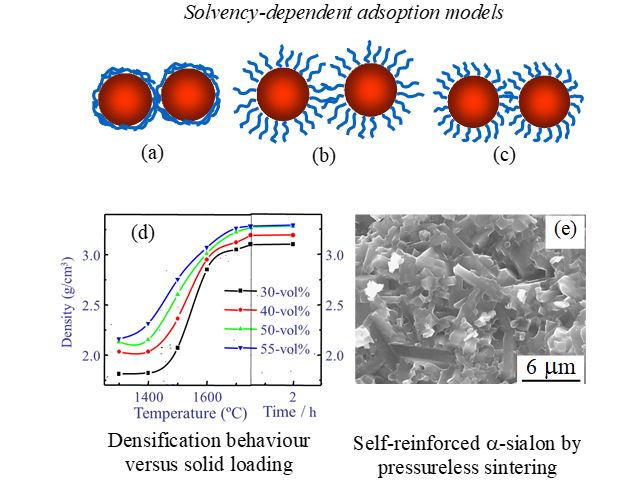Video Article Open Access
Colloidal Processing of Advanced Non-Oxide Ceramics – A Way to Engineer Hard and Tough Materials
José M. F. Ferreira*, Xin Xu
Department of Materials and Ceramics Engineering, CICECO, University of Aveiro, 3810-193 Aveiro, Portugal
Vid. Proc. Adv. Mater., Volume 2, Article ID 2108203 (2021)
DOI: 10.5185/vpoam.2021.08203
Publication Date (Web): 21 Aug 2021
Copyright © IAAM
Graphical Abstract

Abstract
Non-oxide ceramics, including sialons, silicon carbide (SiC) and silicon nitride (Si3N4)-SiC composites, are of great interest for high-temperature refractory applications due to their unique combination of excellent chemical, mechanical and thermal properties. They possess an exceptional resistance to wetting or corrosion by molten non-ferrous metals, compared to other refractory oxide-based materials, high strength at ambient and high temperatures, and good thermal shock resistance. However, the reliability and the fabrications costs still need to be further improved to increase their industrial attractiveness and performance in service. Colloidal processing, which has the potential to destroy the particle agglomerates and control the interactions forces between the particles is a key approach to achieve these challenging targets. However, in multicomponent systems that include powders with much different surface chemistries, etherocoagulation is likely to occurs when dispersing the powders in aqueous media. Moreover, some powders like aluminium nitride (AlN) are water sensitive and undergo hydrolysis, leading to their degradation and formation of by-products. Therefore, solvent mixtures of methyl ethyl ketone (MEK) and ethanol (E) were selected as dispersion media to enhance the surface chemistry compatibility of the different starting powders. Moreover, a comb-like copolymer (Hypermer KD1- Imperial Chemical Industries PLC, England) was used as dispersant due to its versatile architecture consisting of two types of segments, one with high affinity to solid particle surfaces, and the other with high affinity to the solvent. The solvency was further changed by varying the MEK/E volume ratio. The effects of MEK/E solvent mixtures on reaction sialon (76.92-wt.% Si3N4 + 13.46-wt.% AlN + 5.77-wt.% Y2O3 + 3.85-wt.% Al2O3) suspensions were investigated by measuring sedimentation behaviour, adsorption of dispersant and flow behaviour. The efficacy of different homogenizing procedures: high energetic planetary milling, low energetic ball milling and ultrasonication. The effects of different homogenizing routes on the rheology and the maximum achievable solids loading of suspensions and on the properties of slip casting green bodies were also evaluated and compared. It was shown that both the flow behaviour and sedimentation behaviour strongly depended on selection of solvent composition. Using 3-wt.% KD1 as dispersant, well-dispersed colloidal suspensions could be obtained in MEK-rich solvents. Further, the high energetic planetary milling revealed to be the most effective deagglomeration route, enabling to prepare highly concentrated suspensions when powders are dispersed in the azeotropic solvent mixture (MEK/E = 60/40). Predicted adsorption models with varying solvency are proposed. The green bodies with high density could be easily pressureless sintered, leading to homogeneous microstructures of self-reinforced α-sialon with elongated and intermingle grains, enjoying of the greater hardness of α-sialon phase and of the typical higher toughness of β-sialon polymorph. The decreasing solvency of the dispersant with temperature were also exploited to develop a new temperature-induced gelation method and direct consolidate green bodies of SiC and silicon nitride Si3N4-nano-SiC composite ceramics.
Keywords
Colloidal processing; steric stabilization; solvency; rheology; non-oxide ceramics.
Acknowledgement
This work was developed within the scope of the project CICECO-Aveiro Institute of Materials, UIDB/50011/2020 & UIDP/50011/2020, financed by national funds through the FCT/MEC and when appropriate co-financed by FEDER under the PT2020 Partnership Agreement.
References
- X. Xin, M. I. L. L. Oliveira, R. L. Fu, J. M. F. Ferreira, Journal of the European Ceramic Society, 2003, 23, 1525.
- X. Xin, M. I. L. L. Oliveira, J. M. F. Ferreira, Journal of Colloid and Interface Science, 2003, 259, 391.
- X. Xin, M. I. L. L. Oliveira, J. M. F. Ferreira, Journal of the American Ceramic Society, 2003, 86, 366.
- X. Xin, S. Mei, J. M. F. Ferreira, Journal of Materials Research, 2003, 18, 1363.
- X. Xin, S. Mei, T. Nishimura, N. Hirosaki, J. M. F. Ferreira, Journal of Colloid and Interface Science, 2004, 277, 111.
Biography
José M. F. Ferreira is Associate Professor with Habilitation at the Department of Materials and Ceramic Engineering, CICECO – Aveiro Institute of Materials, University of Aveiro. He is the leader of the Advanced Processing Group, and his main research interests include the development and colloidal processing of advanced ceramic and glass materials for various structural and functional materials applications (Microelectromechanical Systems, optical and energy related materials, and materials for applications in biomedicine, especially in dentistry, orthopedics and tissue engineering. Throughout his scientific career, he has supervised 40 Master and 24 PhD students, registered 16 patents, published 6 book Chapters and more than 570 articles in SCI journals, including 2 Feature Articles. He also published 25 articles in referred journals and 92 papers in conference proceedings. He has delivered more than 80 Invited Lectures, including Keynote and Plenary Lectures in international conferences. He is recipient of several awards, including the ‘Stimulus to Excellence – 2005 award’ from the Portuguese Foundation for Science and Technology (FCT); the ‘Chinese Ceramic Society – 2005’ award; the Membership of the World Academy of Ceramics (www.waceramics.org) since July 2013; and the title of Fellow of the European Ceramic Society (ECerS), June 24th, 2015, Toledo, Spain.
Video Proceedings of Advanced Materials

Upcoming Congress



